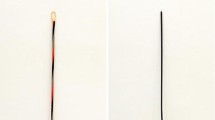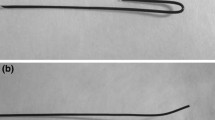Abstract
Background
Deep biliary cannulation is the key for successful endoscopic retrograde cholangiopancreatography (ERCP) procedures. Guidewire-assisted cannulation is associated both with a higher success rate and a reduced risk of post-ERCP pancreatitis compared with standard catheter cannulation. However, to our knowledge there are no prospective, randomized studies comparing the use of different guidewires in biliary cannulation. The goal of this study was to compare the performance of an angled-tipped guidewire (AGW) with a straight-tipped guidewire (SGW) in achieving successful deep biliary cannulation.
Methods
Patients with intended biliary cannulation of an intact papilla were prospectively randomized to angled- or straight-tipped hydrophilic guidewire arms in a tertiary, referral, university hospital setting. Randomized cannulation method was applied either until successful cannulation of the bile duct or until 2 min had passed. Crossover was not included in the study protocol. The main outcome measurements were the cannulation success rate and duration of cannulation.
Results
Of the 239 consecutive patients, 155 patients were randomized: in the final analysis 70 patients were included in the AGW arm and 83 patients in the SGW arm. Cannulation time [median; seconds (s)] was shorter with the AGW compared with the SGW (20 vs. 63 s, p = 0.01). There was no difference in the cannulation success rate or the complication rate between the two study groups.
Conclusions
AGW may facilitate biliary cannulation in ERCP.

Similar content being viewed by others
References
Fukatsu H, Kawamoto H, Kato H, Hirao K, Kurihara N, Nakanishi T, Mizuno O, Okamoto Y, Ogawa T, Ishida E, Okada H, Sakaguchi K (2008) Evaluation of needle-knife precut papillotomy after unsuccessful biliary cannulation, especially with regard to postoperative anatomic factors. Surg Endosc 22:717–723
Gullichsen R, Lavonius M, Laine S, Grönroos J (2005) Needle-knife assisted ERCP. Surg Endosc 19:1243–1245
Williams EJ, Taylor S, Fairclough P, Hamlyn A, Logan RF, Martin D, Riley SA, Veitch P, Wilkinson MN, Williamson PJ, Lombard M; BSG Audit of ERCP (2007) Are we meeting the standards set for endoscopy? Results of a large-scale prospective survey of endoscopic retrograde cholangio-pancreatograph practice. Gut 56:821–829
Katsinelos P, Paroutoglou G, Kountouras J, Chatzimavroudis G, Zavos C, Pilpilidis I, Tzelas G, Tzovaras G (2008) A comparative study of standard ERCP catheter and hydrophilic guide wire in the selective cannulation of the common bile duct. Endoscopy 40:302–307
Cennamo V, Fuccio L, Zagari RM, Eusebi LH, Ceroni L, Laterza L, Fabbri C, Bazzoli F (2009) Can a wire-guided cannulation technique increase bile duct cannulation rate and prevent post-ERCP pancreatitis? A meta-analysis of randomized controlled trials. Am J Gastroenterol 104:2343–2350
Cheung J, Tsoi KK, Quan WL, Lau JY, Sung JJ (2009) Guidewire versus conventional contrast cannulation of the common bile duct for the prevention of post-ERCP pancreatitis: a systematic review and meta-analysis. Gastrointest Endosc 70:1211–1219
Lee TH, Park do H, Park JY, Kim EO, Lee YS, Park JH, Lee SH, Chung IK, Kim HS, Park SH, Kim SJ (2009) Can wire-guided cannulation prevent post-ERCP pancreatitis? A prospective randomized trial. Gastrointest Endosc 69:444–449
Grönroos JM, Vihervaara H, Gullichsen R, Laine S, Karvonen J, Salminen P (2011) Double-guidewire-assisted biliary cannulation: experiences from a single tertiary referral center. Surg Endosc 25:1599–1602
Cotton PB, Lehman G, Vennes J, Geenen JE, Russell RCG, Meyers WC, Liguory C, Nickl N (1991) Endoscopic sphincterotomy complications and their management: an attempt at consensus. Gastrointest Endosc 37:383–393
Siegel JH, Pullano W (1987) Two new methods for selective bile duct cannulation and sphincterotomy. Gastrointest Endosc 33:438–440
Bailey AA, Bourke MJ, Williams SJ, Walsh PR, Murray MA, Lee EY, Kwan V, Lynch PM (2008) A prospective randomized trial of cannulation technique in ERCP: effects on technical success and post-ERCP pancreatitis. Endoscopy 40:296–301
Nambu T, Ukita T, Shigoka H, Omuta S, Maetani I (2011) Wire-guided selective cannulation of the bile duct with a sphincterotome: a prospective randomized comparative study with the standard method. Scand J Gastroenterol 46:109–115
Vihervaara H, Salminen P, Hurme S, Gullichsen R, Laine S, Grönroos JM (2011) Female gender and post-ERCP pancreatitis: is the association caused by difficult cannulation? Scand J Gastroenterol 46:1498–1502
Bailey AA, Bourke MJ, Kaffes AJ, Byth K, Lee EY, Williams JS (2009) Needle-knife sphincterotomy: factors predicting its use and the relationship with post-ERCP pancreatitis (with video). Gastrointest Endosc 71:266–271
Disclosures
Hanna Vihervaara, Juha M. Grönroos, Mari Koivisto, Risto Gullichsen, and Paulina Salminen have no conflicts of interest or financial ties to disclose.
Author information
Authors and Affiliations
Corresponding author
Rights and permissions
About this article
Cite this article
Vihervaara, H., Grönroos, J.M., Koivisto, M. et al. Angled- or straight-tipped hydrophilic guidewire in biliary cannulation: a prospective, randomized, controlled trial. Surg Endosc 27, 1281–1286 (2013). https://doi.org/10.1007/s00464-012-2596-6
Received:
Accepted:
Published:
Issue Date:
DOI: https://doi.org/10.1007/s00464-012-2596-6




